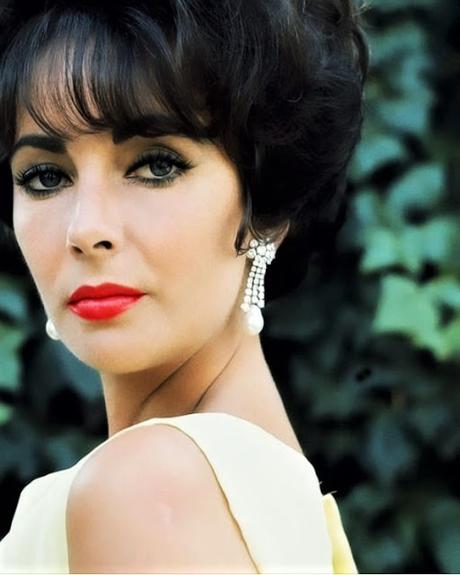
This is my entry for "The Wedding Bells Blogathon" hosted by Hometowns to Hollywood
~
She exchanged wedding vows for the first time at age 18 in 1950 and married for the eighth and final time in 1991 at 59. Of her apparent proclivity for collecting husbands, actor/composer/raconteur Oscar Levant would razz Elizabeth Taylor with the quip, "Always a bride, never a bridesmaid!"
~
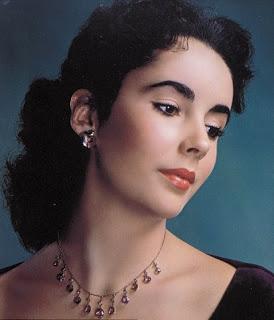
Elizabeth Taylor in 1948
She was born in England, the daughter of a mild-mannered art dealer and his wife, an ambitious former stage actress. Both parents were originally from the U.S. and would return to America with their children, Elizabeth and her older brother Howard, in 1939 as war descended on Europe. The family settled in Los Angeles and her father opened a gallery in Beverly Hills. Elizabeth was a very pretty child, with dark hair, pale skin and striking blue-violet eyes and, through her father's client contacts in the film industry, her mother would have her auditioning for movies by the time she was nine. She appeared in MGM's Lassie Come Home (1943) and went on to have small roles in Jane Eyre (1943) and The White Cliffs of Dover (1944) before becoming a child star with the leading role in National Velvet (1944) opposite Mickey Rooney. In her mid-teens she was able to make the transition from preadolescent to ingenue roles in films like Life with Father (1947) and A Date with Judy (1948).By 1950, Elizabeth Taylor was on the verge of womanhood and already a veteran actress with a dozen films to her credit. She was feeling a little restless, chafing at life under her parents roof and the seemingly all-pervasive oversight of MGM. Enter Conrad ("Nicky") Hilton, Jr., son and heir of the founder of Hilton Hotels. 26 at the time, he was rich, handsome and smitten, and seemed to Elizabeth like the ideal mate at the ideal moment. Serendipitously, while she was being courted by Hilton, she was also making Father of the Bride (1950). Spencer Tracy portrayed the harried, put-upon father and Elizabeth played his beautiful and enraptured bride-to-be daughter. With Vincente Minnelli directing, a bright and witty script from Frances Goodrich and Albert Hackett (Easter Parade, Seven Brides for Seven Brothers) and the full support of MGM, the film could hardly miss. And it didn't. Father of the Bride was released on May 18, 1950, just 12 days after Elizabeth Taylor became Mrs. Hilton - a publicist's dream coordinated and paid for by MGM. The movie was a box office smash...and the Taylor/Hilton marriage was big news. Elizabeth's gown in the film, fashioned by Helen Rose, would go on to become the most copied wedding dress pattern in America. Rose also designed the more revealing but similarly styled gown Elizabeth wore for her wedding to Nicky Hilton.
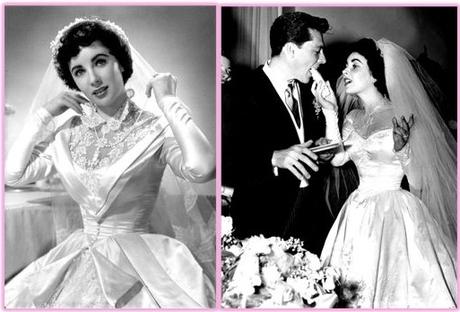
1950: Two gowns by Helen Rose: left, for Father of the Bride and right, the Taylor/Hilton nuptials
Although Father of the Bride was a runaway hit - it even spawned the sequel Father's Little Dividend (1951) - Elizabeth and Nicky Hilton didn't fare nearly so well; their marriage lasted only eight months. It would emerge that Hilton had problems with drinking, gambling and his temper, along with a roving eye, and was wholly unprepared for a marriage in the limelight.

1952: Elizabeth Taylor marries Michael Wilding
It would be just a year following her divorce from Hilton that wedding bells rang a second time for Elizabeth Taylor, then a week short of her 20th birthday. Her much-ballyhooed marriage to Nicky Hilton had collapsed so quickly and dramatically that their divorce attracted sensational news coverage; it was Elizabeth Taylor's first brush with notoriety. When she married British actor Michael Wilding, a man 20 years her senior, she seemed to be looking for stability and security. The pair would be married for five mostly unremarkable years and have two sons. Their marital life may ultimately have been too staid for a still young Elizabeth (she was later quoted as saying they'd become more like "brother and sister") and while her career continued to rise, his languished. In the end, tabloid publicity helped bring down the marriage. While she was in Texas filming Giant (1956), he apparently invited a pair of strippers into their home and the incident found its way into the pages of Confidential magazine, the infamous scandal sheet of that era. Taylor and Wilding divorced in 1957. She was now 25 years old with sons two- and four-years-old. She was also now a major movie star. Her screen presence and star potential had been gorgeously on display in George Stevens' A Place in the Sun (1951) opposite an equally stunning Montgomery Clift. In The Last Time I Saw Paris (1954) she portrayed a Zelda Fitzgerald-like siren opposite Van Johnson; it was a role that further demonstrated her allure and gift for drama. Her next film was Giant, another Stevens film and a record-breaking blockbuster that co-starred Rock Hudson and James Dean. She would follow Giant with Raintree County (1957). A much-anticipated but overlong echo of Gone With the Wind set in the deep South, it also starred Montgomery Clift and Eva Marie Saint. Elizabeth Taylor received her first Oscar nomination for her performance and would very soon begin her reign as a superstar, the Hollywood star of the '50s and early '60s and the highest paid actress in the world. A third marriage was also on her very near horizon.Mike Todd was 25 years older than Elizabeth Taylor and, by the time they met, had worked his way up from running a construction business to becoming a "theatrical impresario," and producing on Broadway. Lately he had moved into film production. He was one of the co-founders of Cinerama but left that company to develop an improved widescreen process. Todd-AO was the result and it was first used on the film adaptation of Oklahoma! (1955). He was a man who lived and dreamed large and he would reach the apex of his varied career in 1957 when he won an Academy Award for Best Picture. Two days after her divorce from Michael Wilding was final, Elizabeth Taylor, three weeks from her 25th birthday, would marry him.
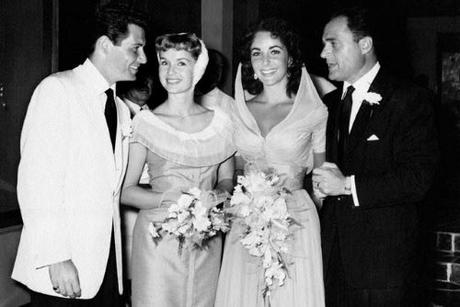
1957: Elizabeth Taylor marries Mike Todd; in attendance, at left, Eddie Fisher and wife Debbie Reynolds
Theirs was a brief but colorful marriage. It began shortly before he won the Best Picture Oscar for the only feature film he would ever produce, Around the World in 80 Days (1956). Six months after the wedding she would give birth to their only child, Liza, and seven months after that he would die, the victim of a fiery plane crash. The brief but glitzy Taylor/Todd marriage was heavily covered by the media. They were a Hollywood power couple and both "Liz and Mike" were outspoken and brash and made for great press copy.
Elizabeth Taylor was filming Cat on a Hot Tin Roof (1958) at the time of the plane crash. Fatefully, this is would be the film, an MGM movie Todd had encouraged his wife to make, that would establish her status as a Hollywood top-liner. As Maggie, the "cat on a hot tin roof," she was once more blessed with a character that fit her to a tee: voluptuous, sensual and volatile. She would receive her second Best Actress Oscar nomination for her performance.
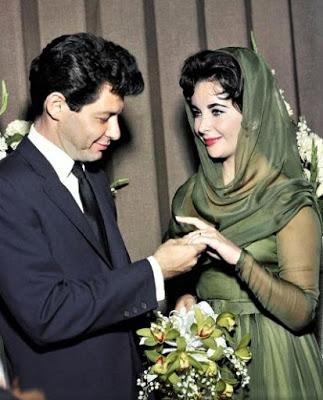
May 12, 1959, Elizabeth Taylor marries Eddie Fisher
But filming would be interrupted for some weeks following Mike Todd's death. Elizabeth's family and friends, her handlers and even MGM hair stylist Sydney Guilaroff, all kept a close eye on her during the early grieving period. As time passed she would seek particular solace from Mike Todd's good friend, his best man at their wedding, singer Eddie Fisher. Fisher's wife Debbie Reynolds had been Elizabeth's maid of honor.By August 1958 reports were beginning to surface that "Liz and Eddie" were in New York having an affair. Gossip columnists on both coasts fought to get the real story, and on September 11 Hedda Hopper's rapidly transcribed telephone interview with Elizabeth would hit the front page of the L.A. Times. It was in this interview that Taylor had made several too-candid comments that would brand her as a "homewrecker" and much worse. She had been carelessly cavalier and offhand in her remarks about Fisher's marriage and when asked what Mike Todd would think of her behavior, she reportedly snapped, "Mike's dead and I'm alive!" Then there was the question she should never have uttered to a gossip columnist, "What do you expect me to do? Sleep alone?" Hedda's scandalous scoop was picked up by newspapers around the country and around the globe.This was Elizabeth Taylor's first experience with the fallout that comes with public spectacle and controversy. In the end it would be Eddie Fisher who paid the price for the scandal and resulting backlash. He'd had a successful singing career that brought him a popular TV musical variety show, Coke Time, in 1954. The program was renamed The Eddie Fisher Show in 1957 and was now sponsored by Chesterfield cigarettes. But with the uproar over the Liz-Eddie-Debbie debacle, the show was cancelled in 1959; NBC and Chesterfield had been inundated with complaints from viewers, many of whom would boycott Chesterfield, and Fisher's ratings plummeted. Soon enough he became better known as "Mr. Elizabeth Taylor" and his career never rebounded.
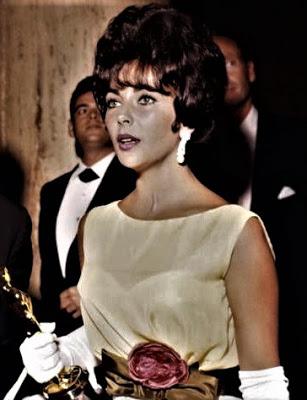
Elizabeth Taylor on Oscar night 1961
Elizabeth Taylor's career was not damaged. Though she continued to be pilloried for breaking up the Fisher marriage and "immoral behavior," she was also making hit films, films that exploited her image as a seductress. In 1959 she starred opposite Katharine Hepburn and Montgomery Clift in the steamy psychodrama Suddenly, Last Summer and garnered her third Best Actress Oscar nomination. Butterfield 8 (1960) a racy pot-boiler about a "party girl," brought her a fourth nomination.In 1961 she began filming Cleopatra in London with Rouben Mamoulian directing. She was paid $1,000,000 to star, the first actress to receive such a fee. But the shoot got off to a rocky start and Elizabeth, who by now frequently suffered health problems, fell seriously ill and eventually was rushed to the hospital with pneumonia. She nearly died and, in fact, her death was widely reported around the world. Her survival seemed miraculous - and in one way it was; it transformed her reputation. No longer was she the fallen woman, she was now the brave survivor of near-death. When she accepted the Best Actress Oscar for Butterfield 8 not long after her health crisis, the fresh scar on her throat from an emergency tracheotomy was still clearly visible. A heart-rending moment. For a while she was beloved again but her respite from scandal was brief.
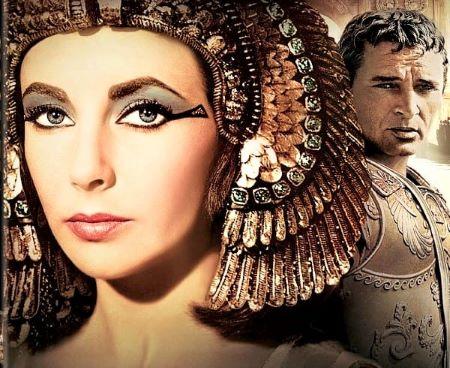
Elizabeth Taylor and Richard Burton, Cleopatra (1963)
When the production of Cleopatra resumed, Rouben Mamoulian was out and Joseph Mankiewicz was in, all previous footage was scrapped and filming was moved from London to Rome. In no time Elizabeth Taylor and Richard Burton would begin their first film together - and more.
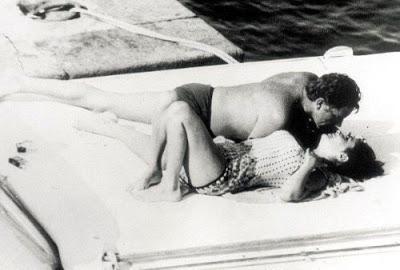
1962: The photo that launched a worldwide scandal
The two had initially - and uneventfully - met years earlier, when she was married to Michael Wilding. It would be a different matter from the first day the pair worked together on the Cleopatra set. Burton had a hangover that fateful day and his vulnerability and difficulty in preparing for their scene touched her heart. In addition, according to one of her biographers, "Elizabeth was having her own romance with alcohol" then and may have had a special sympathy for Burton's condition. But it was their first love scene for Cleopatra that let everyone on the set who witnessed it know that something more than acting was going on between Elizabeth Taylor and Richard Burton. The scene was repeated many times and eachsaid time their kiss lasted longer than the last. When Joe Mankiewicz finally , "Print it," the two continued kissing. The director would eventually call out, "Would you two mind if I say cut?" From then on, the pair was reportedly inseparable. As Mike Nichols would later describe it, "two fatally glamorous people...became each other's lives." Eddie Fisher would become ex-husband number four and Richard Burton would leave his wife and children to marry her. As "Liz and Dick," the couple became tabloid fodder, a prime target of the paparazzi, for the next fourteen tumultuous years.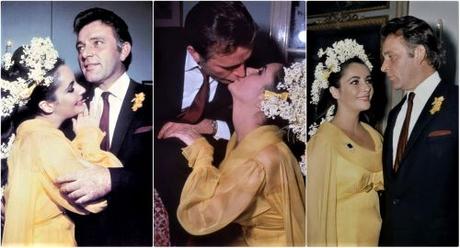
1964: the first wedding of Elizabeth Taylor and Richard Burton
Richard Burton, a Welsh actor who had been one of the great stars of the London stage, had taken Broadway by storm as King Arthur in Camelot when it opened in 1960. While he'd appeared in many films before Cleopatra, this was the film that brought him stardom. He would make eleven films opposite Elizabeth Taylor, including The V.I.P.s (1963), Who's Afraid of Virginia Woolf? (1966) and The Taming of the Shrew (1967), and be nominated for seven Academy Awards in the course of his career. Elizabeth Taylor would win another Best Actress Oscar for her performance in Virginia Woolf but her film career would begin to decline in the late '60s. "Liz and Dick" were more than movie stars, though, they were international superstars, jet-setting (or yachting) the globe, living a circus-like existence with heads turning and flashbulbs popping wherever they went. Endless world travel, epicurean feasting, flowing liquor, the lavishing of priceless jewelry - and melodrama, much of it played out in the spotlight, came with a price. As one close to them described it, "They got trapped in the trappings of their life." They would divorce in 1974, remarry late in 1975 and divorce again and finally, in 1976. Years later, in 1983, the pair would headline a much ballyhooed production of Noel Coward's Private Lives on Broadway, but it was not a great success.
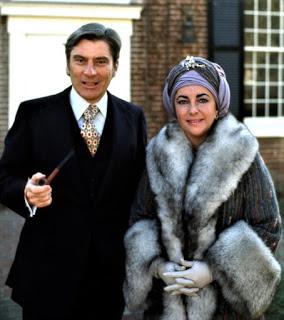
1976: John Warner and Elizabeth Taylor
Richard Burton would be a hard act to follow, but Elizabeth Taylor was not one to give up easily. In 1976, not very long after Burton re-married, she would wed John Warner, a wealthy Virginian who had served as U.S. Secretary of the Navy under Richard Nixon. Two years after their marriage Warner would win his bid for public office and become a Republican Senator from Virginia. He would ultimately serve six terms, from January 1979 until January 2009. During his tenure Warner would chair the Senate Rules Committee from 1995 - 1999, and chair the Senate Armed Services Committee from 2003 - 2007. The Senator's congressional career would far outlast his marriage to Elizabeth Taylor. Never meant to be a "Washington wife," she did not fit into the political social scene and became frustrated and bored. She was also drinking, overusing prescription pain pills and gaining weight. The nadir of this period may have come in November 1978 when John Belushi impersonated her on Saturday Night Live in a skit. Belushi depicted her during an interview in which she, overweight and in disarray, stuffed herself with fried chicken as she answered questions. In 1982 she and Warner would divorce.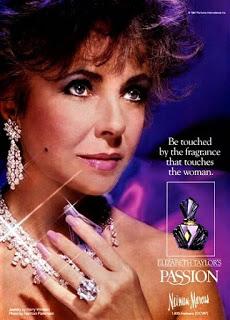
During the 1980s she would also go through a dramatic makeover in appearance, slimming down and undergoing superb cosmetic work. She would also take steps to address her issues with alcohol and prescription drugs. It was while she was in treatment at the Betty Ford Center in Rancho Mirage, California, in 1988 that she met the man who would become her final husband.
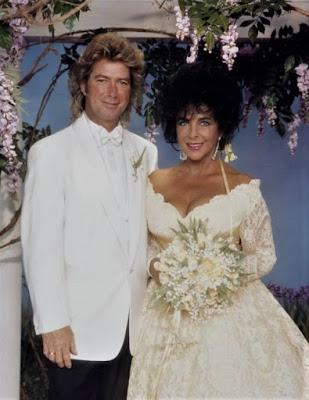
1991: Larry Fortensky and Elizabeth Taylor
Larry Fortensky was a construction worker and former trucker twenty years Elizabeth Taylor's junior who was being treated at the clinic for alcohol addiction. The pair bonded during treatment. Their 1991 wedding would be a media carnival. The ceremony took place at Michael Jackson's Neverland Ranch with Marianne Williamson, the New Age spiritual leader (and recent Democratic presidential candidate), officiating. Press coverage was over the top, with one photographer apparently resorting to parachuting his way onto the Jackson estate.Larry Fortensky and Elizabeth Taylor's marriage would last for five years, though they separated earlier. They divorced in 1996 but would remain in contact for the rest of her life. She would, along with providing him with a generous divorce settlement, continue to help him financially over the years and leave him an inheritance in excess of $800,000.
~
Elizabeth Taylor lived a long life that included many romances as well as her eight marriages. But in the end, she only ever spoke of one great love. That, of course, was Richard Burton. Late in life she would say, "After Richard, the men in my life were just there to hold the coat, to open the door. All the men after Richard were really just company." She would stipulate in her will that she be buried next to him, but that was not to be. Burton had been buried in Switzerland where he lived and died in 1984 at age 58. Elizabeth's grave is at Forest Lawn in Southern California, the final resting place of so many of the great stars of Hollywood.
~ For links to all blog posts participating in Hometowns to Hollywood's fabulous "Wedding Bells Blogathon," click here!
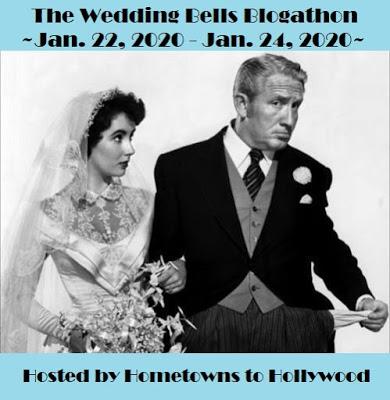
Sources:
How to Be a Movie Star: Elizabeth Taylor in Hollywood by William J. Mann (Houghton Mifflin Harcourt, 2009)
Furious Love: Elizabeth Taylor, Richard Burton and the Marriage of the Century by Sam Kashner and Nancy Schoenberger (HarperCollins, 2010)

